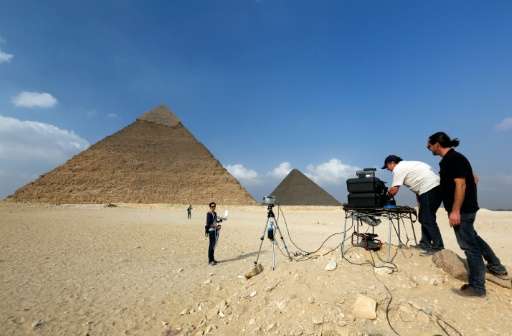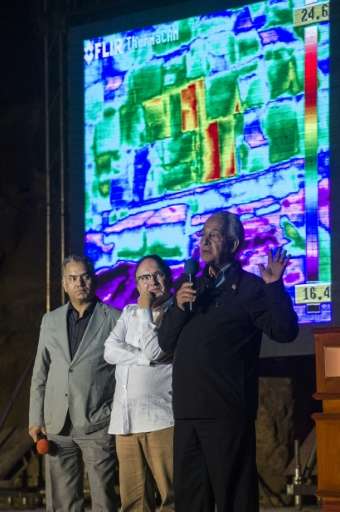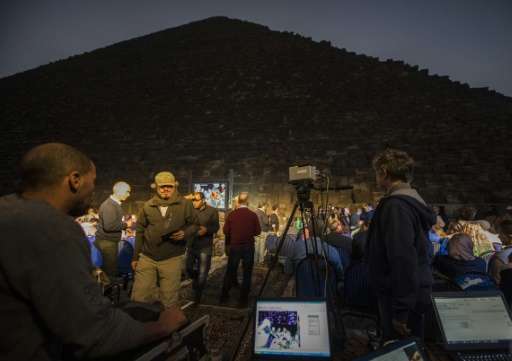High-tech scans look to unravel mysteries of Egypt pyramids

New findings at Egypt's Khufu pyramid are raising hopes of unravelling the mysteries of one of the ancient world's most iconic monuments, including whether it may contain secret chambers.
Using the latest infrared technology—a far cry from the down-and-dirty methods of the "Indiana Jones" films—a team of researchers from Egypt, France, Canada and Japan have been scanning four of Egypt's famed pyramids with thermal cameras.
Operation ScanPyramids began on October 25 to search for hidden rooms inside Khufu, also known as the Great Pyramid, and Khafre at Giza and the Bent and Red pyramids in Dahshur, all south of Cairo.
The project is expected to continue until the end of 2016, but two weeks in, the experts announced at a news conference at the foot of Khufu that they had already made some remarkable findings.
Observations were made during infrared scanning of limestone blocks as they heat up and cool during different times of the day.
"Several thermal anomalies were observed on all (four) monuments, during the heating up or the cooling down phases," said a statement released by the team of experts and Egypt's antiquities ministry.
"A lot of hypothesis and possibilities could be drawn from those observations: presence of voids behind the surface, internal air currents, different materials with specific thermal capacity," it said.
In particular, it said, an "impressive" anomaly was found "on the eastern side of the Khufu pyramid at ground level" that could indicate the existence of a secret chamber.
The team is made up of experts from the Cairo University faculty of engineering as well as from the French HIP (Heritage Innovation Preservation) Institute.
The technology applied is a mix of infrared thermography, muon radiography imaging and 3D reconstruction—all of which the researchers say are non-invasive and non-destructive techniques.

The goal is to try to see if unknown structures or cavities are present inside the famed ancient monuments "which may lead to a better understanding of their structures and their construction process".
Antiquities Minister Mamduh al-Damati told reporters the new finds were only a beginning.
Picture of the year
"We should discover more things about the pyramids," he said.
The most exciting findings focused on some of the limestone blocks that make up Khufu's eastern flank.
While some of these huge blocks showed cool temperatures, others just nearby were remarkably hotter, in some cases by up to six degrees Celsius, he said.
A video projection of the data recorded by the thermal cameras showed hues of red and yellow covering the blocks where heat was detected and blue and magenta for the cooler ones.
"This is the most important picture of 2015," Damati said.

Egyptologist Ashraf Mohie said the anomalies detected on Khufu pyramid represent "an unprecedented discovery".
The team has said it will carry out more investigations that will include "further treatment and data analysis" of the anomalies so far detected.
The next phase of operations will include 3D modelling and simulations of the Giza plateau "which will definitely lead to a better understanding of the plans and techniques of pyramid construction".
Earlier this month, the team tested their scanning equipment inside the tomb of boy king Tutankhamun in Egypt's Valley of the Kings in the southern town of Luxor.
Temperature differences were detected on parts of the northern wall of the tomb in what could support a British archaeologist's theory that Queen Nefertiti, or another royal, is also buried there.
Archaeologists have never discovered the mummy of the legendary beauty, but renowned British archaeologist Nicholas Reeves said in a recent study that her tomb could be in a secret chamber adjoining Tutankhamun's tomb.
At 146 metres (480 feet) tall, Khufu pyramid, named after the son of pharaoh Snefru, is considered one of the seven wonders of the ancient world, built some 4,500 years ago.
It has three known chambers, and like other pyramids in Egypt was intended as a pharaoh's tomb.
© 2015 AFP





















